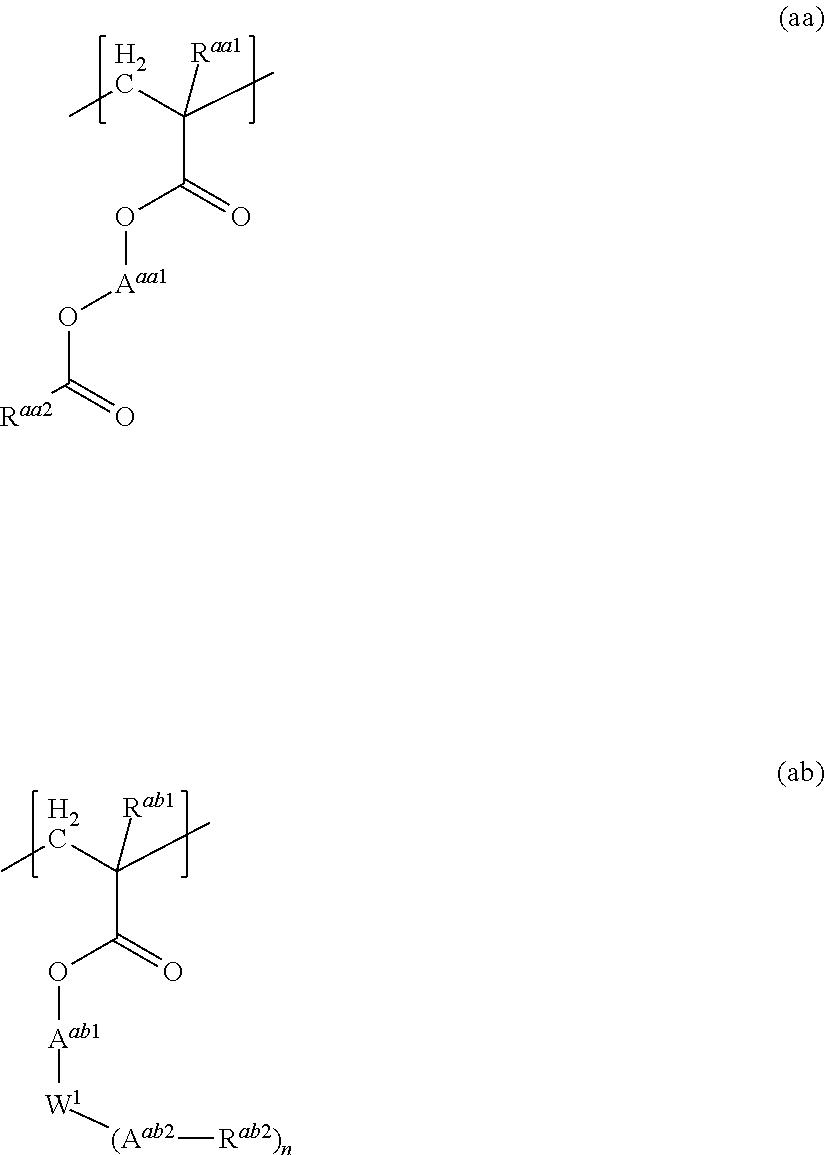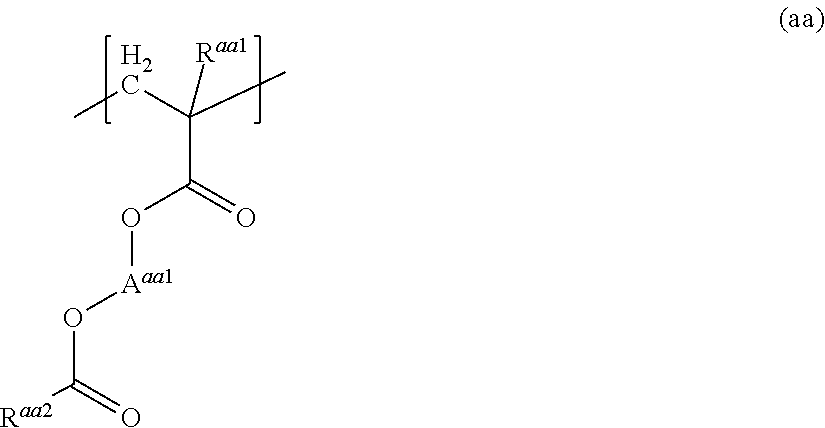Resist composition and method for producing resist pattern
a composition and resist technology, applied in the direction of photomechanical equipment, microlithography exposure equipment, photosensitive materials, etc., can solve the problem that the critical dimension uniformity (cdu) of the obtained resist pattern may not always be satisfied, and achieve the effect of excellent cdu and few defects in the obtained resist pattern
- Summary
- Abstract
- Description
- Claims
- Application Information
AI Technical Summary
Benefits of technology
Problems solved by technology
Method used
Image
Examples
synthesis example 1
Synthesis of Compound (M-E)
[0782]
[0783]10.00 parts of a compound (E-2), 40.00 parts of tetrahydrofuran and 7.29 parts of pyridine were mixed, and stirred for 30 minutes at 23° C. The obtained mixture was cooled to 0° C. To this mixture was added 33.08 parts of a compound (E-1) over 1 hour while maintaining at the same temperature. The temperature of the mixture was then elevated to about 23° C., and the mixture was stirred for 3 hour at the same temperature. Thus obtained reactant was added to 361.51 parts of ethyl acetate and 20.19 parts of 5% of hydrochloric acid solution to obtain a mixture, the mixture was stirred for 30 minutes at 23° C. The obtained solution was allowed to stand, and then separated to recover an organic layer. To the recovered organic layer, 81.42 parts of a saturated sodium hydrogen carbonate was added, and the obtained solution was stirred for 30 minutes at 23° C., allowed to stand, and then separated to recover the organic layer. To the recovered organic la...
synthesis example 2
Synthesis of Compound (M-L)
[0785]
[0786]88.00 parts of a compound (L-2), 616.00 parts of methyl isobutyl ketone and 60.98 parts of pyridine were mixed, and stirred for 30 minutes at 23° C. The obtained mixture was cooled to 0° C. To this mixture was added 199.17 parts of a compound (L-1) over 1 hour while maintaining at the same temperature. The temperature of the mixture was then elevated to about 10° C., and the mixture was stirred for 1 hour at the same temperature. Thus obtained reactant was added to 1446.22 parts of n-heptane and 703.41 parts of 2% of hydrochloric acid solution to obtain a mixture, the mixture was stirred for 30 minutes at 23° C. The obtained solution was allowed to stand, and then separated to recover an organic layer. To the recovered organic layer, 337.64 parts of 2% of hydrochloric acid solution was added to obtain a mixture, and the mixture was stirred for 30 minutes at 23° C. The obtained solution was allowed to stand, and then separated to recover an orga...
synthesis example 3
Synthesis of Compound (M-M)
[0788]
[0789]9.60 parts of a compound (M-2), 38.40 parts of tetrahydrofuran and 5.99 parts of pyridine were mixed, and stirred for 30 minutes at 23° C. The obtained mixture was cooled to 0° C. To this mixture was added 14.00 parts of a compound (M-1) over 1 hour while maintaining at the same temperature. The temperature of the mixture was then elevated to about 10° C., and the mixture was stirred for 1 hour at the same temperature. Thus obtained reactant was added to 14.51 parts of the compound (M-4) and 8.20 parts of the compound (M-5), and stirred for 3 hours at 23° C. To the reacted solution, 271.95 parts of ethyl acetate and 16.57 parts of 5% of hydrochloric acid solution was added to obtain a mixture, the mixture was stirred for 30 minutes at 23° C. The obtained solution was allowed to stand, and then separated to recover an organic layer. To the recovered organic layer, 63.64 parts of a saturated sodium hydrogen carbonate was added, and the obtained s...
PUM
 Login to View More
Login to View More Abstract
Description
Claims
Application Information
 Login to View More
Login to View More - R&D
- Intellectual Property
- Life Sciences
- Materials
- Tech Scout
- Unparalleled Data Quality
- Higher Quality Content
- 60% Fewer Hallucinations
Browse by: Latest US Patents, China's latest patents, Technical Efficacy Thesaurus, Application Domain, Technology Topic, Popular Technical Reports.
© 2025 PatSnap. All rights reserved.Legal|Privacy policy|Modern Slavery Act Transparency Statement|Sitemap|About US| Contact US: help@patsnap.com



